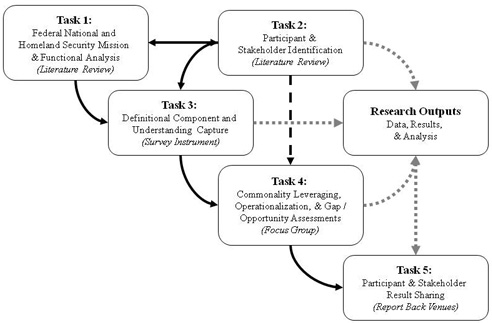Environmental Security Project
Environmental Security Resource Center
George Mason University

Project Approach
Objectives
This research project’s specific objectives were to:
- Capture U.S. national security and homeland security practitioners’ and policymakers’ current understandings of environmental security;
- Identify common definitional components and attributes that conceptually bridge, operationalize, and could add value in meeting institutional mission, policy, and operational challenges; and
- Understand current capability needs and existing resources within U.S. national security and homeland security communities of practice.
Methodology
The effort utilized three specific research methods:
- Comprehensive literature review
- Email survey
- Focus group workshop
First, a comprehensive literature review identified federal
agencies’ and departments’ national security, homeland security,
environmental, and development missions and functionalities. This
review also identified potential participants and compiles their host
organization, mission, position, and contact information. Second, an
e-mail survey captured practitioners’ understandings of environmental
security, its relevance for their institution’s mission and operations,
and any known environmental security capability gaps and tools needed.
Third, a project workshop developed participants’ shared understanding
of environmental security, identified the concept’s institutional
relevance and implications, explored capability needs and resources,
and generated participant consensus and ownership.
Project Overview By Task
To achieve these objectives, the project’s research plan is broken
down into five separate yet complementary tasks. They are part of
an action research approach and are broken out to include:
- Task 1: Federal National and Homeland Security Mission and Functional Analysis
- Task 2: Participant and Stakeholder Identification
- Task 3: Definitional Component and Understanding Capture
- Task 4: Commonality Leveraging, Operationalization, and Gap / Opportunity Assessments
- Task 5: Participant and Stakeholder Result Sharing
